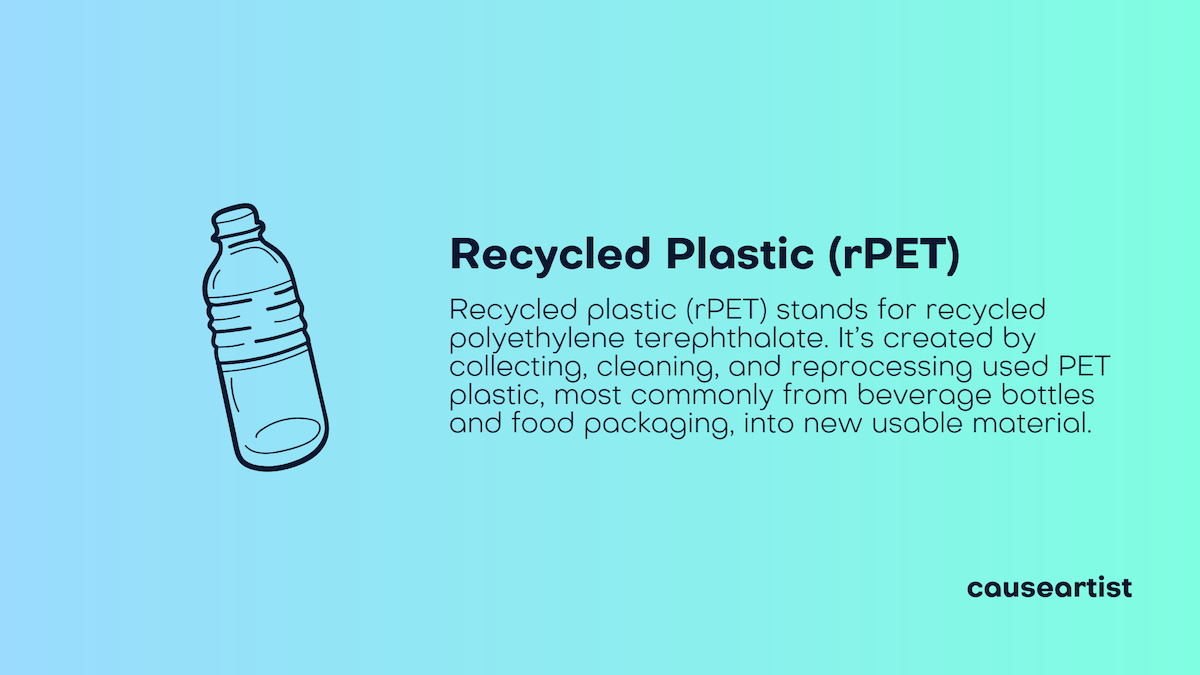Plastic waste has become one of the most pressing environmental challenges of our time. Every year, more than 400 million tons of plastic are produced worldwide, and less than 10% is recycled according to the United Nations Environment Programme.
Among the different types of plastic, polyethylene terephthalate (PET)—used in water bottles, food containers, and textiles, is one of the most common.
The recycled form of PET, known as rPET, has emerged as a cornerstone of sustainable manufacturing and packaging.
Here’s why: rPET reduces virgin plastic production, lowers greenhouse gas emissions, and keeps waste out of oceans and landfills.
Let’s break down what rPET really is, how it’s made, and how it’s shaping the future of sustainable packaging.
What Is Recycled Plastic (rPET)?
Recycled plastic (rPET) stands for recycled polyethylene terephthalate. It’s created by collecting, cleaning, and reprocessing used PET plastic, most commonly from beverage bottles and food packaging, into new usable material.
rPET retains many of the same qualities as virgin PET: clarity, strength, and food safety when properly processed.
Because of this, rPET is now widely used in:
- Beverage and water bottles
- Clothing and textiles (polyester fiber)
- Food containers
- Cosmetic and cleaning product packaging
In short, rPET gives plastic a second life, transforming what was once waste into a resource for new products.
The Science Behind PET and rPET
PET is a thermoplastic polymer, meaning it can be melted down and reshaped multiple times without losing its integrity.
That makes it ideal for recycling.
The base structure of PET consists of ethylene glycol and terephthalic acid, both derived from petroleum. During recycling, these polymers are broken down and purified before being reformed into rPET pellets.
There are two main recycling methods used to create rPET:
1. Mechanical Recycling
This is the most common and cost-effective process.
- Used PET bottles are collected and sorted.
- Labels and caps are removed.
- The plastic is shredded into flakes, washed, and melted.
- The melted flakes are turned into pellets and molded into new products.
2. Chemical Recycling
This method breaks PET down into its base monomers, allowing for infinite recycling potential.
- The plastic is depolymerized using heat and chemicals.
- Purified monomers are then repolymerized to create high-quality rPET identical to virgin PET.
- Though more expensive, it ensures consistent quality and safety for food-grade applications.

The Environmental Benefits of rPET
Recycled plastic offers significant environmental advantages over virgin PET.
🌎 1. Reduced Carbon Footprint
Producing rPET requires up to 60% less energy than virgin plastic and emits nearly 50% fewer greenhouse gases (PlasticsEurope, 2022).
🔁 2. Circular Economy Integration
rPET embodies the circular economy model—keeping materials in use for as long as possible. It shifts plastic’s lifecycle from “take, make, waste” to “collect, recycle, reuse.”
♻️ 3. Waste Reduction
Using rPET diverts millions of plastic bottles from landfills and oceans every year. In 2023, global use of rPET saved an estimated 7.4 million barrels of oil equivalent, according to ICIS Analytics.
💧 4. Water and Energy Savings
Recycling PET consumes less water and energy than producing new plastic, reducing strain on natural resources.
Challenges and Limitations of rPET
Despite its promise, rPET isn’t without hurdles.
1. Contamination
Food residue, mixed materials, and non-PET plastics can compromise recycling efficiency and safety.
2. Color Variability
Recycled flakes often vary in color, limiting their use in clear or transparent packaging without additional treatment.
3. Cost Fluctuations
While recycling is cheaper in the long run, virgin PET can sometimes be less expensive depending on oil prices—creating market imbalances.
4. Supply Chain Gaps
Global demand for rPET far exceeds available supply. Many brands have pledged to use 50–100% recycled content by 2030, but there simply isn’t enough high-quality rPET yet to meet that target.
Real-World Applications of rPET
Today, rPET is used in nearly every consumer goods sector, with packaging leading the way.
Food & Beverage
Brands like Coca-Cola, Waiākea Hawaiian Volcanic Water, and Evian are introducing bottles made from 100% rPET.
Fashion & Textiles
rPET is spun into recycled polyester fiber, powering the sustainable apparel movement. Companies like Patagonia and Girlfriend Collective use rPET fabrics to reduce waste from plastic bottles.
Consumer Goods
Beauty and cleaning brands increasingly use rPET packaging to meet corporate sustainability goals and reduce environmental impact.
Regulatory and Certification Standards
Ensuring rPET safety and quality requires strict compliance with regulatory frameworks.
- FDA (U.S.) and EFSA (EU) regulate food-contact recycled plastics.
- Global Recycled Standard (GRS) certifies recycled content and ethical production.
- ISO 15270 provides global guidelines for plastics recycling and recovery.
These standards guarantee that rPET products meet safety, performance, and traceability requirements across industries.
The Future of rPET and Sustainable Packaging
As governments, consumers, and corporations push for greener materials, rPET is set to become a cornerstone of the low-carbon economy.
Emerging innovations include:
- AI-powered sorting systems for better material recovery.
- Chemical recycling plants scaling globally.
- Bio-based PET alternatives that combine renewable feedstocks with recyclability.
By 2030, analysts expect global rPET production to exceed 10 million tons annually, cutting over 25 million tons of CO₂ emissions per year.
How Consumers Can Support the rPET Movement
- Recycle correctly. Rinse and sort bottles to reduce contamination.
- Buy products made with rPET. Check packaging for recycled content labels.
- Support brands investing in circular packaging.
- Advocate for better recycling infrastructure in your community.
Every small action contributes to scaling the circular economy and reducing plastic pollution.
Key Takeaways
✅ rPET = Recycled PET plastic, derived from used bottles and containers.
✅ Mechanical and chemical recycling methods give it new life.
✅ Up to 60% lower energy use and 50% fewer emissions than virgin plastic.
✅ Plays a crucial role in circular economy and sustainable packaging.
✅ Challenges remain, but innovation is rapidly improving efficiency and scalability.








